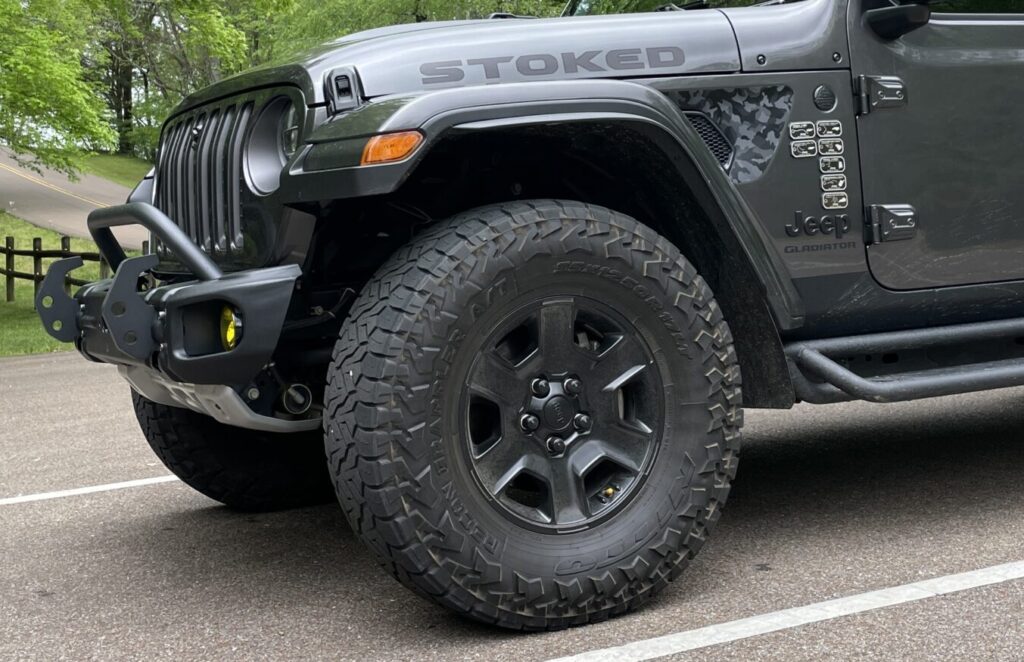
I’ve compiled this Jeep Gladiator Tire Guide because if you own a JT (Jeep Gladiator,) chances are you’ve already looked at the tires and wondered how much bigger you can go. Tires are usually the first upgrade—partly for looks, partly for capability, and partly because the right set of rubber makes a huge difference in how your truck feels on the road. Lets face it, the Gladiator looks pretty derpy with anything less than a 33-inch tire. Flared fenders demand more beef!
This guide is written with the weekend warrior and overlanding crowd in mind. If your Gladiator pulls double duty—commuting during the week and adventuring on the weekends—this one’s for you. We’ll leave the hardcore rock-crawling setups out of the conversation and focus on practical, everyday upgrades.
Stock Gladiator Tire Sizes by Trim
Jeep ships the Gladiator in several trims, each with its own factory tire package:
- Sport / Sport S – 245/75R17 all-seasons. Light, efficient, highway-focused.
- Overland – 255/70R18 all-seasons. Slightly larger, tuned for comfort and cruising.
- Mojave – 285/70R17 all-terrains. (33’s) Designed for high-speed desert use, tougher load rating.
- Rubicon – 285/70R17 mud-terrains. (33’s) Aggressive tread for off-road traction.
While these setups work great out of the box, most owners eventually want something amazing – larger for style or added clearance.
How Big Can You Go Without Major Mods?
The most common question Gladiator owners ask: what’s the largest tire I can fit without a lift or heavy modifications?
- 33’s (285/70R17 or 285/75R17)
- Bolt-on ready for nearly all trims.
- Adds ground clearance and trail confidence without hurting drivability.
- Little to no effect on fuel economy if you stick with all-terrains.
- 35’s
- On Rubicon or Mojave: often fit stock suspension with the right wheels or backspacing.
- On Sport/Overland: usually requires a leveling kit or light trimming.
- Strikes a great balance for weekend rigs—more aggressive stance, capable off-road, but still livable day-to-day.
- 37’s+
- At this size, you’re looking at lift kits, re-gearing, and supporting mods.
- Cool factor is high, but the practicality drops fast for daily-driver duty.
- Not recommended unless you’re building something beyond an overlanding setup.
Jeep Gladiator Tire Guide – Pros and Cons by Tire Size
🛞 Stock Sizes
- Pros: Smoothest ride, best fuel economy, lowest cost.
- Cons: Limited off-road traction, “skinny” look.
33’s
- Pros: Best all-around option for most Gladiator owners. More aggressive stance without hurting MPG.
- Cons: May still feel modest if you want a show-stopper look.
35’s
- Pros: Big step up in presence and trail clearance. Excellent compromise between style and utility.
- Cons: Small hit to fuel economy. Heavier tire = more stress on components.
37’s+
- Pros: Maximum visual impact, unbeatable clearance.
- Cons: Expensive (requires other upgrades + mods) harder on driveline, not ideal for a truck that sees weekday road duty.

Matching Tires to Driving Habits
Your choice should reflect how you really use your Gladiator:
- Daily Drivers – 33s with mild all-terrains for smooth road manners.
- Weekend Warriors – 35s hit the sweet spot of style, capability, and utility.
- Overlanding / Long Trips – Prioritize load rating, tread life, and balance between highway comfort and trail grip.
- Towing & Hauling – Consider tire load ratings over size. Heavier tires can reduce payload and towing efficiency.
🛞 Gladiator Tire Size Quick Reference
| Metric Size | Approx. Size (inches) | Est. Added Clearance* | Est. Reduced MPG* | Notes / Fitment |
|---|---|---|---|---|
| 245/75R17 | ~31.5" × 9.6" | 0.0" | ≈ 0 MPG | Stock Sport / Sport S |
| 255/70R18 | ~32.1" × 10.0" | 0.1" | ≈ 0 MPG | Stock Overland |
| 285/70R17 | ~32.7" × 11.2" | 0.4" | ≈ −0.5 to −1.0 MPG | Stock Mojave & Rubicon |
| 285/75R17 | ~33.8" × 11.2" | 0.9" | ≈ −1.0 to −2.0 MPG | Popular 33" upgrade |
| 315/70R17 | ~34.4" × 12.4" | 1.2" | ≈ −1.5 to −2.5 MPG | Common 35" upgrade |
| 35×12.50R17 | True 35" × 12.5" | 1.5" | ≈ −1.5 to −2.5 MPG | Leveling kit often needed (non-Rubicon) |
| 35×12.50R17 (Mickey Thompson Baja Boss A/T) | ~34.8" × 12.5" | 1.4" | ≈ −1.5 to −2.5 MPG | Hybrid A/T; 50K warranty; 3PMS severe snow rated |
| 37×12.50R17 | True 37" × 12.5" | 2.5" | ≈ −2.5 to −4.0 MPG | Lift & supporting mods required |
*Estimates vs ~32" stock baseline. Real numbers depend heavily on tire model, tread pattern, wheel/tire weight, axle ratio, terrain, speed, load, and driving style. Use this chart as a directional guide, not a guarantee.
Utility vs. Style: Finding the Balance
Let’s be honest—upgrading tires is as much about looks as function. Bigger tires transform the Gladiator’s stance, but they come with tradeoffs:
- Fuel Economy – larger tires = lower MPG.
- Road Noise – aggressive tread patterns are louder.
- Hidden Costs – bigger tires can shorten brake life, add wear to axles, and bump replacement costs.
The trick is matching your tire to your lifestyle. If most of your driving is on-road with the occasional forest service road or camping trip, 33’s or 35’s will keep your Jeep both practical and adventurous.
additional Notes:
- Metric sizes (e.g., 285/70R17) are what you’ll see on most tire listings.
- Inch sizes (e.g., 35×12.50R17) are common in off-road marketing but not always “exact.” Actual diameters vary by brand and model.
- Width matters: 12.5” wide tires often require aftermarket wheels or spacers for proper clearance.
- Inch sizes (e.g., 35×12.50R17) are common in off-road marketing but not always “exact.” Actual diameters vary by brand and model.
- Caution: The more you move away from factory-tested geometry, the more likely you are to experience adverse effects and ultimately mechanical failure. This is a critical consideration when planning long, backcountry expeditions where your repair and replacement options disappear like trail dust.
Tire Load Ratings: What They Mean for Your Gladiator
Common Ratings You’ll See on Gladiator-Friendly Tires:
- Load Range C (6-ply rated)
- Softer sidewalls, lighter construction.
- Typically rated up to ~50 PSI.
- Great for daily driving comfort and light off-road.
- Downsides: not ideal if you tow heavy or run low pressures often.
- Load Range D (8-ply rated)
- Middle ground — stronger than C, not as harsh as E.
- Good for overlanding rigs with moderate gear loads.
- Often harder to find compared to C or E.
- Load Range E (10-ply rated)
- Very common in Gladiator-sized all-terrains and mud-terrains.
- Max pressures ~80 PSI, designed for heavy-duty trucks.
- Pros: higher durability, great for towing, hauling, or rocky terrain.
- Cons: stiffer ride, heavier tire (hurts MPG & acceleration).
- Load Range F (12-ply rated)
- Overkill for most Gladiators. Found on big diesel truck tires.
- Extremely stiff — not recommended unless you’re running max payloads often.
What’s Best for an overlanding Gladiator rig?
- Daily Driver / Weekend Trips: Load C or D for comfort and lighter weight.
- Overlanding Setup with Gear: Load E if you’re carrying roof tents, full camp setups, or towing trailers.
- Towing / Utility Work: Load E makes sense here — stronger sidewalls, less squirm under load.
Why It Matters
- Ride Comfort: C-rated tires ride smoother and flex more, E-rated ride stiffer.
- Durability: E-rated sidewalls resist punctures better in rocky terrain.
- Fuel Economy: Heavier E-rated tires knock MPG down faster than lighter C/D.
- Airing Down: C and D flex easier when aired down for trail comfort, while E takes more PSI drop to achieve the same footprint.
Here are a few tried-and-true favorites among Gladiator owners, with links to both the manufacturer sites (for full specs) and Amazon (for easy purchase):
Popular Tire Choices
- BFGoodrich All-Terrain T/A KO2
Legendary all-terrain balance. Great traction in nearly every condition with long tread life.
👉 See on Amazon - Falken Wildpeak AT3W
A fan favorite for Jeep owners. Strong off-road grip, excellent wet traction, and surprisingly good highway manners.
👉 See on Amazon - Nitto Ridge Grappler (Georgia Made)
Hybrid tread design blends mud-terrain looks with all-terrain comfort. Aggressive stance without sacrificing too much road performance.
👉 See on Amazon - Toyo Open Country A/T III
Built tough with long tread life and great balance for highway + trail. A dependable option for overlanding setups.
👉 See on Amazon - Mickey Thompson Baja Boss A/T (Alabama made)
Hybrid all-terrain with aggressive looks and on-road polish. Asymmetric tread and silica compound reduce noise while boosting grip; backed by a 50K-mile warranty and 3PMS severe snow rating (on sizes 12.5″ / 315 mm and narrower). Common Gladiator fit: 35×12.50R17 LT (~34.8″ diameter).
👉 See on Amazon
Bottom line
I run 35’s. I love them. At the end of the day, your tire choice comes down to lifestyle, budget, and priorities. For most Gladiator owners who daily drive their rigs but love a weekend escape, 33’s or 35’s are the real sweet spot. You’ll gain capability and curb appeal without compromising too much on comfort or efficiency.
So before you order that next set, ask yourself: Am I building for Instagram, or for real-world adventure?
Either way, the road (or dirt road) is waiting.
Tread lightly and Gladiator Up! – Doug
Disclaimer
All recommendations in this guide are general guidelines—tire fitment depends on wheel choice, suspension setup, and model year. Always confirm sizing with a tire shop or your Jeep dealer before purchase.
Some of the links in this post are affiliate links, which means I may earn a small commission if you purchase through them—at no extra cost to you.
AI assisted in researching and refining this post.
